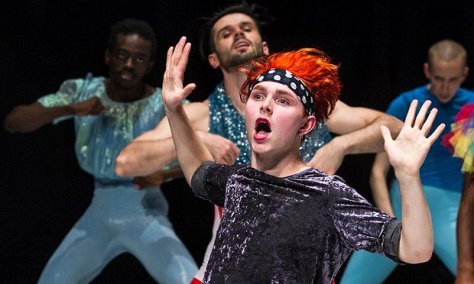Here’s a list of some of the things that seem to me to restrict independent dance artists in the UK at the moment
- lack of sufficient, appropriate financial support
- institutional systems that prioritise reach, engagement, and impact so that artists end up trying to meet agendas set by funding bodies and producers rather than their own artistic priorities and needs.
- a dearth of physical space in which to make work, and then a dearth of opportunities for showing it and, in particular, a lack appropriate and supportive ones for untested new ideas.
- a discursive vacuum, a lack of outlets for artistic discussions around innovative dance practices (choreography, performance, training etc.) thus inhibiting the development of a context for its reception and dissemination.
- internalised restrictions, things that one perhaps doesn’t even recognise one refrains from thinking, let alone doing, for fear of making waves or going out on a limb. How easy is it for example to challenge ideologically contaminated assumptions about artistic freedom and individualism?
These thoughts came to me after two events I attended on the same evening in the final week of Dance Umbrells 2016. These were the talk Body Politic 2016: freedom of movement. How does a climate of censorship affect art? and a performance of Gala by Jérôme Bel.
Can one call the restrictions I’ve outlined here censorship? I associate censorship with the Law, something about which I don’t claim to have much understanding. The idea of censorship brings to mind legislation around the distribution of violent or pornographic material. One recent prominent example of this kind of body politics (though not one mentioned in the Body Politic event) was the case where Pandora Blake made a successful legal challenge against the Audio Visual Media Services regulations. She has pointed out that these, in effect, favour porn made for heterosexual male customers while banning video of practices relating to female pleasure and to those of sexual minorities (see https://www.theguardian.com/culture/2016/jun/06/feminist-pornographer-wins-right-reinstate-sadomasochism-website-pandora-blake and http://pandorablake.com/blog).
Natalia Kalinda of Belarus Free Theatre (http://www.belarusfreetheatre.com/) who was one of the speakers at the Body Politic event, talked about making live performance work in Belarus and how to tackle the abusive censorship in that country. She went on to point out, however, that in her opinion arts funding systems in the UK are comparable to censorship in countries like Belarus because financial pressures can be as restrictive as political censorship.
Jamila Johnson-Small, also on the panel, spoke about what she perceived to be a problematic when she performed or, as she put it, made an exhibition of herself. She read from a blog in which she asks herself ‘how do I not climb into a cage of my own making’. (https://jamilajohnsonsmall.wordpress.com/2015/06/04/on-silence-and-invisibility/) She talked about the constant physical negotiation of institutional systems, and of how to work within them without being taken over by them.
What kind of freedoms do such negotiations offer? That was the thought I took with me to Jérôme Bel’s Gala which I went on to see after the talk.
Gala reminded me of Bel’s Disabled Theatre which I saw during Dance Umbrella 2015. In the former the cast are made up of people who are autistic or have downs syndrome, while the cast of Gala includes a range of people ranging from pre-teens to someone who I thought was 70 or over, BME people, people with disabilities, and gender queer folk. A few were professional dancers or performers while most were untrained amateurs.

[Gala, Dance Umbrella 2016, Photograph: Foteini Christofilopoulou 2016 from The Guardian]
In both pieces the participants seem to have been given tasks to perform which they then execute on stage on their own one after the other, with some group material at the end. I remember Bel saying last year that, in Disabled Theatre, the performers were free to do whatever they wanted, and that he couldn’t have made them do what he wanted if he tried. In Gala I assume there was a similar intention to give the performers freedom to do whatever they want without interference. The programme notes that they each chose their own costumes.
Whereas Disabled Theatre received quite a mixed reception, Gala seems to have been well received (see Judith Mackrell’s review for example). I’ve met people who loved it. The people I found myself sitting next to at Sadlers Wells had seen it at the Bernie Grant Centre and liked it so much that they’d come back to see it again. Interestingly they weren’t even regular dance goers. There was a standing ovation the night I saw it. But (did you sense there was a ‘but’ coming?) I felt uneasy about Gala.
I felt that the idea that the performers were free to do whatever they wanted was illusory. Its attraction as an idea comes from the idea of freedom that underpins the individualism encouraged by the consumer culture of C21st capitalism. I thought the performers in Gala were completely controlled by the rational system that Bel had devised. They were obedient, always performing their tasks faithfully without embellishment, event in the ‘Michael Jackson’ themed section when the audience’s laughs and cheers must have tempted some of them to add a little extra embellishment while they were still on stage.
The structure of Gala could be compared with that of a tv show like Britain’s Got Talent albeit with a more avant-garde aesthetic. In Johnson-Small’s terms, the work allowed the performers to climb into cages of their own making. Giving Gala a standing ovation seemed to me to be giving a stamp of approval to a system as totalising and controlling as that of most of our increasingly precarious working lives under neoliberal austerity.
And it is that system that people like Natalia Kalinda point out we need to resist.

I like a good whinge or rant but realistically that is not enough (Eeyore has always been one of my favourite characters). Somehow we need to do something. But what? well, I don’t have a real answer to this but just some suggestions, ones that comes from a workshop by Paul Mason that I attended at the Momentum fringe conference The World Transformed during the Labour Party Conference in Liverpool last month.
What Mason said there seems to be based on a recent blog he wrote Find each other and act! Twelve principles for a neo-Bevanite left (https://medium.com/mosquito-ridge/find-each-other-and-act-dd566b812732#.lyabzjtae) Here are extracts from some of these principles that we might think about translating into tactics suitable to the needs of independent dance artists.
- Understand what’s really happening.
- Exercise free speech.
- Form affinity groups.
- Emulate social movements.
- Resist in a way that forces those in power into a “decision dilemma”
- Think of every action in three parts: prepare, act, reflect
- Design actions either to communicate or to achieve concrete goals
- Act in a way that reframes the story; re-set the narrative
- Be peaceful, funny and human
- Link to the wider progressive movement.
- Learn new ideas. Or teach people.
- It’s their media but it’s our voice.
- Populate the media. The letters pages, radio phone-in programmes, audience Q&As, vox pops — they are all spaces [in which a] radical voice needs to be heard. (…)
- Create waves through social media. The newspapers and TV are important because they maintain a monopoly of distribution. The internet breaks that monopoly. Social media, no matter how heavily policed and distorted by algorithms, is an important tool in our fight for social justice. It can bring to the palm of everybody (i) truth (ii) undistorted arguments (iii) periodic calls to do something.
- We need our own media. (…) The point is not to make propaganda. It is to report the news fairly, in a way the mainstream media will not do. In the short term we need a way of aggregating the content produced by small alternative media; professionalising what they do … (selected extracts from Paul Mason’s blog)
Is there a way of adapting Mason’s programme that might offer potentials for dealing with the restrictions I outlined at the start of this blog post?

